Impact of Social Media Marketing on FIFA World Cup 2010 & 2014
VerifiedAdded on 2024/07/12
|10
|2123
|451
Report
AI Summary
This report provides an analysis of the impact of social media marketing on the FIFA World Cup events of 2010 and 2014, comparing it to traditional media approaches. It evaluates the effectiveness of social media in promoting the events, highlights the issues faced by the associations in leveraging social media platforms, and contrasts the adoption and impact of social media between the two World Cups. The report details how social media evolved from an embryonic stage in 2010 to a dominant force in 2014, significantly altering sports coverage and fan engagement, while also addressing the challenges related to technical capabilities and cultural sensitivities in utilizing social media for global event promotion. The research uses statistics and references to support its findings, concluding with a critical evaluation of social media's role in transforming event marketing.
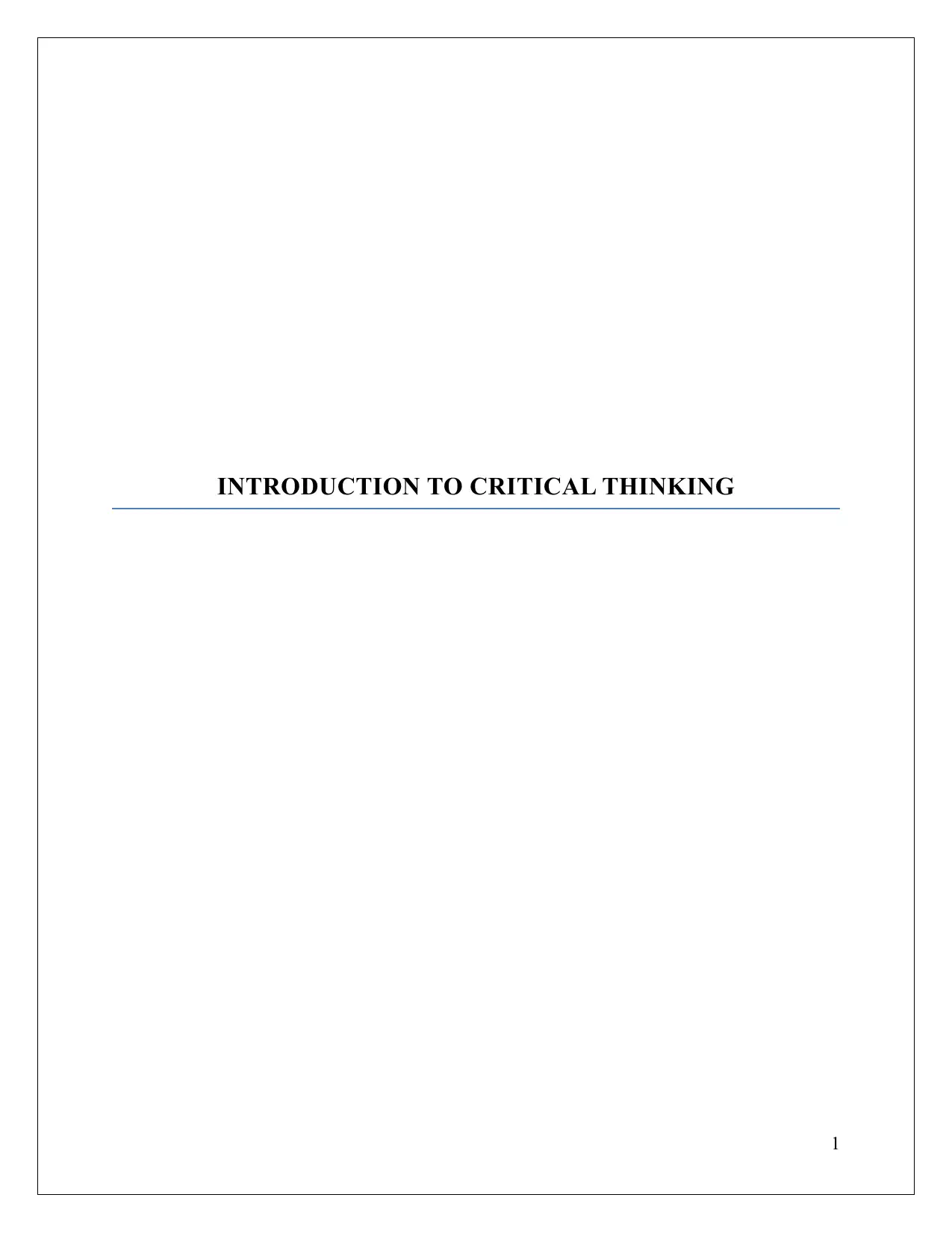
INTRODUCTION TO CRITICAL THINKING
1
1
Paraphrase This Document
Need a fresh take? Get an instant paraphrase of this document with our AI Paraphraser
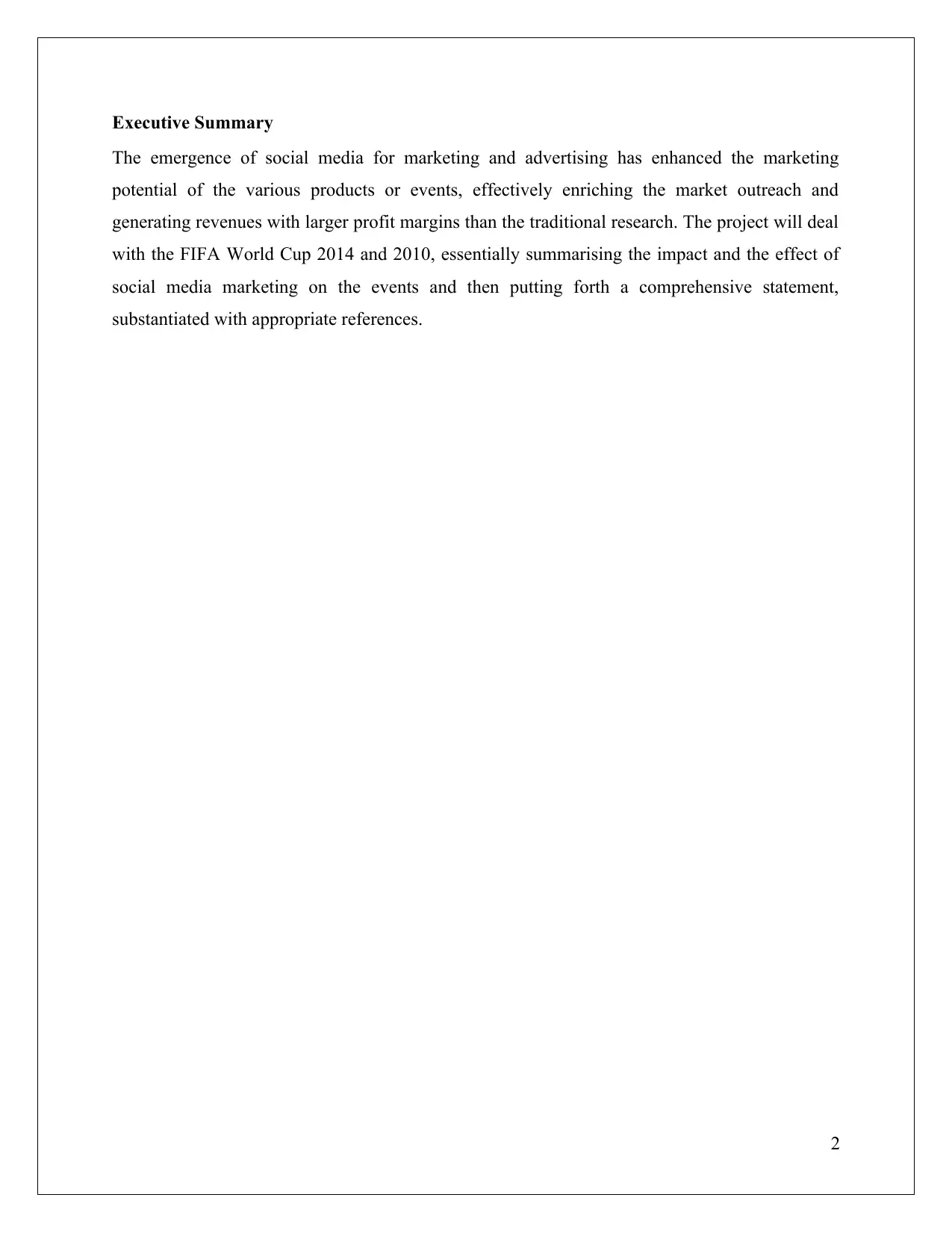
Executive Summary
The emergence of social media for marketing and advertising has enhanced the marketing
potential of the various products or events, effectively enriching the market outreach and
generating revenues with larger profit margins than the traditional research. The project will deal
with the FIFA World Cup 2014 and 2010, essentially summarising the impact and the effect of
social media marketing on the events and then putting forth a comprehensive statement,
substantiated with appropriate references.
2
The emergence of social media for marketing and advertising has enhanced the marketing
potential of the various products or events, effectively enriching the market outreach and
generating revenues with larger profit margins than the traditional research. The project will deal
with the FIFA World Cup 2014 and 2010, essentially summarising the impact and the effect of
social media marketing on the events and then putting forth a comprehensive statement,
substantiated with appropriate references.
2
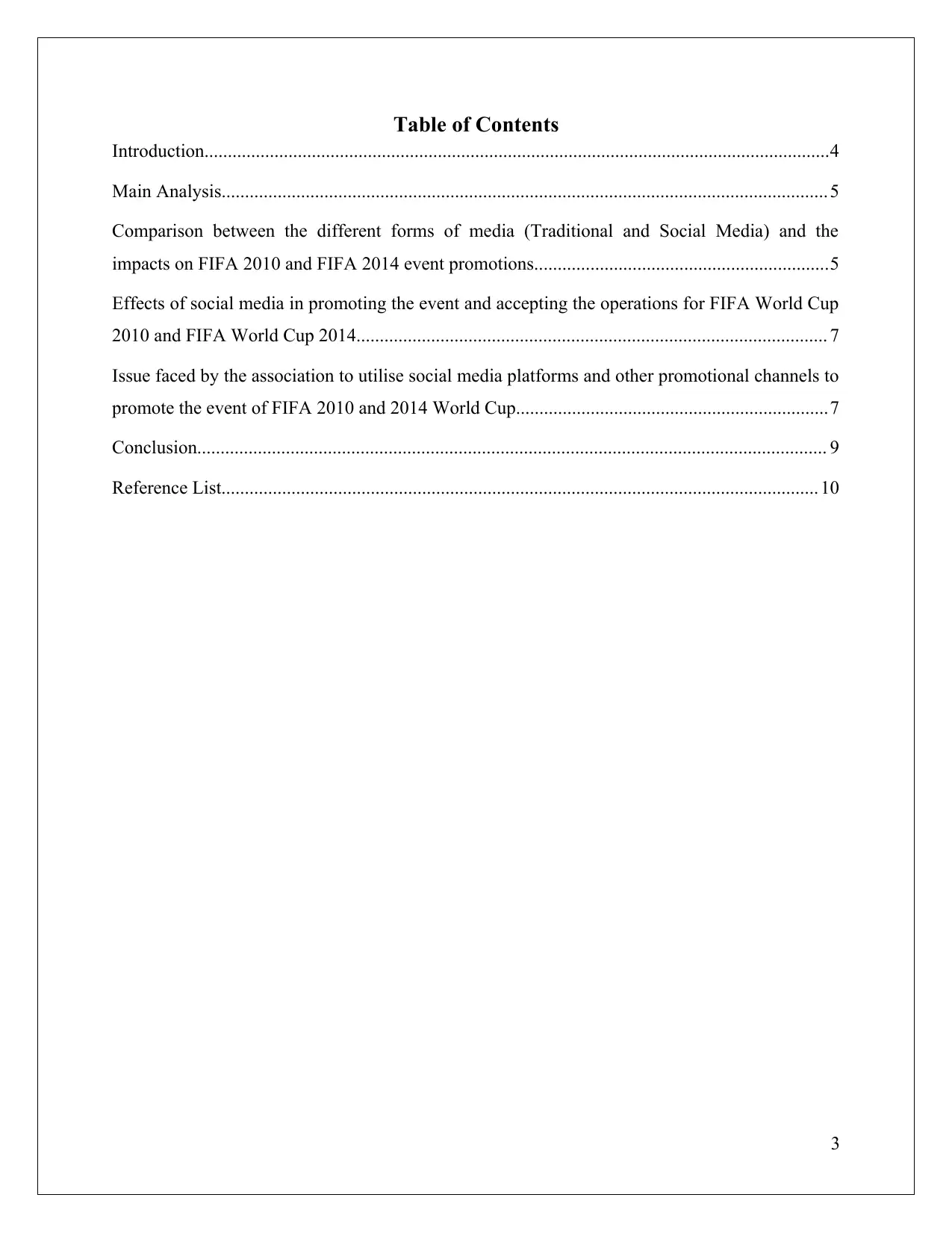
Table of Contents
Introduction......................................................................................................................................4
Main Analysis.................................................................................................................................. 5
Comparison between the different forms of media (Traditional and Social Media) and the
impacts on FIFA 2010 and FIFA 2014 event promotions...............................................................5
Effects of social media in promoting the event and accepting the operations for FIFA World Cup
2010 and FIFA World Cup 2014..................................................................................................... 7
Issue faced by the association to utilise social media platforms and other promotional channels to
promote the event of FIFA 2010 and 2014 World Cup...................................................................7
Conclusion....................................................................................................................................... 9
Reference List................................................................................................................................ 10
3
Introduction......................................................................................................................................4
Main Analysis.................................................................................................................................. 5
Comparison between the different forms of media (Traditional and Social Media) and the
impacts on FIFA 2010 and FIFA 2014 event promotions...............................................................5
Effects of social media in promoting the event and accepting the operations for FIFA World Cup
2010 and FIFA World Cup 2014..................................................................................................... 7
Issue faced by the association to utilise social media platforms and other promotional channels to
promote the event of FIFA 2010 and 2014 World Cup...................................................................7
Conclusion....................................................................................................................................... 9
Reference List................................................................................................................................ 10
3
⊘ This is a preview!⊘
Do you want full access?
Subscribe today to unlock all pages.

Trusted by 1+ million students worldwide
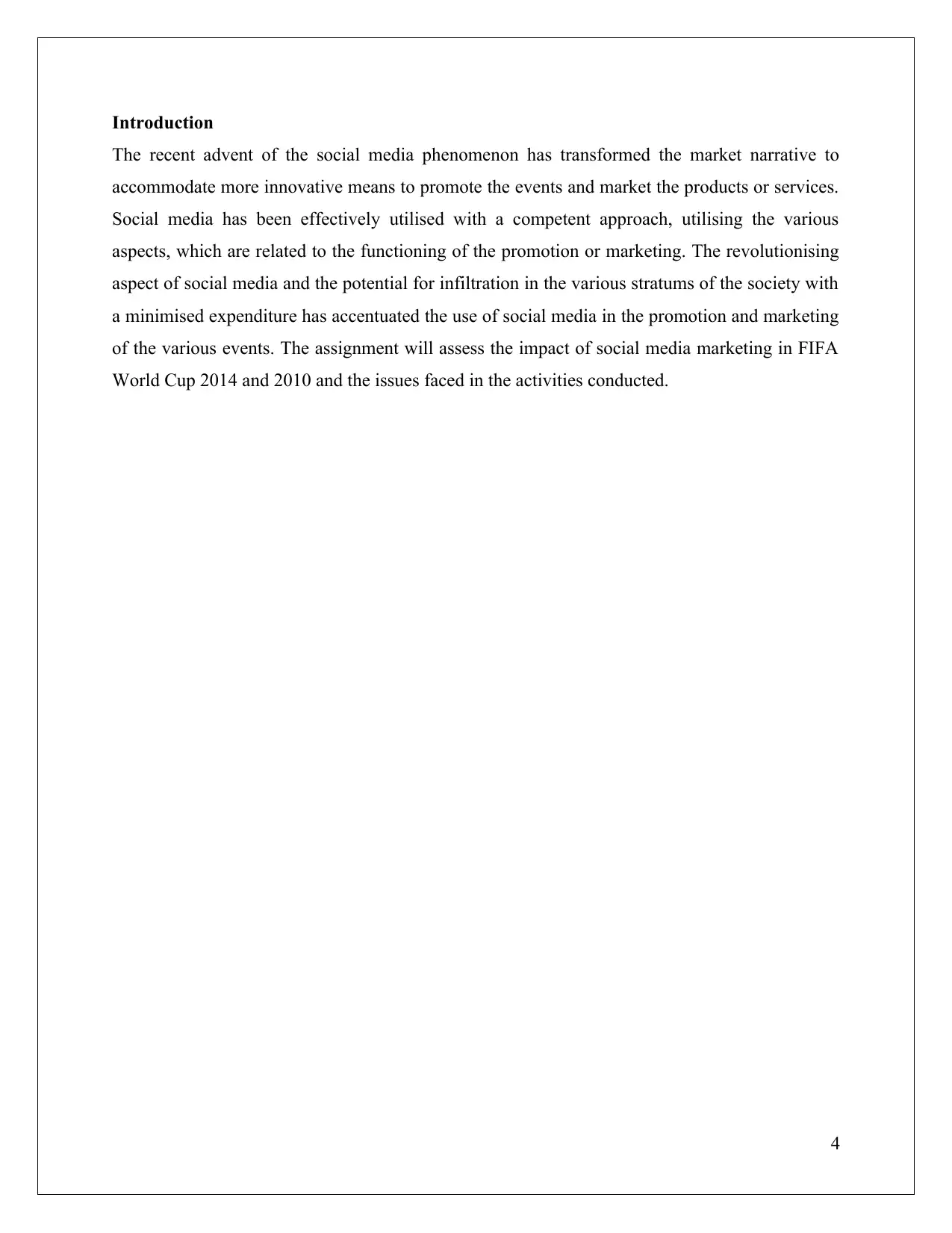
Introduction
The recent advent of the social media phenomenon has transformed the market narrative to
accommodate more innovative means to promote the events and market the products or services.
Social media has been effectively utilised with a competent approach, utilising the various
aspects, which are related to the functioning of the promotion or marketing. The revolutionising
aspect of social media and the potential for infiltration in the various stratums of the society with
a minimised expenditure has accentuated the use of social media in the promotion and marketing
of the various events. The assignment will assess the impact of social media marketing in FIFA
World Cup 2014 and 2010 and the issues faced in the activities conducted.
4
The recent advent of the social media phenomenon has transformed the market narrative to
accommodate more innovative means to promote the events and market the products or services.
Social media has been effectively utilised with a competent approach, utilising the various
aspects, which are related to the functioning of the promotion or marketing. The revolutionising
aspect of social media and the potential for infiltration in the various stratums of the society with
a minimised expenditure has accentuated the use of social media in the promotion and marketing
of the various events. The assignment will assess the impact of social media marketing in FIFA
World Cup 2014 and 2010 and the issues faced in the activities conducted.
4
Paraphrase This Document
Need a fresh take? Get an instant paraphrase of this document with our AI Paraphraser
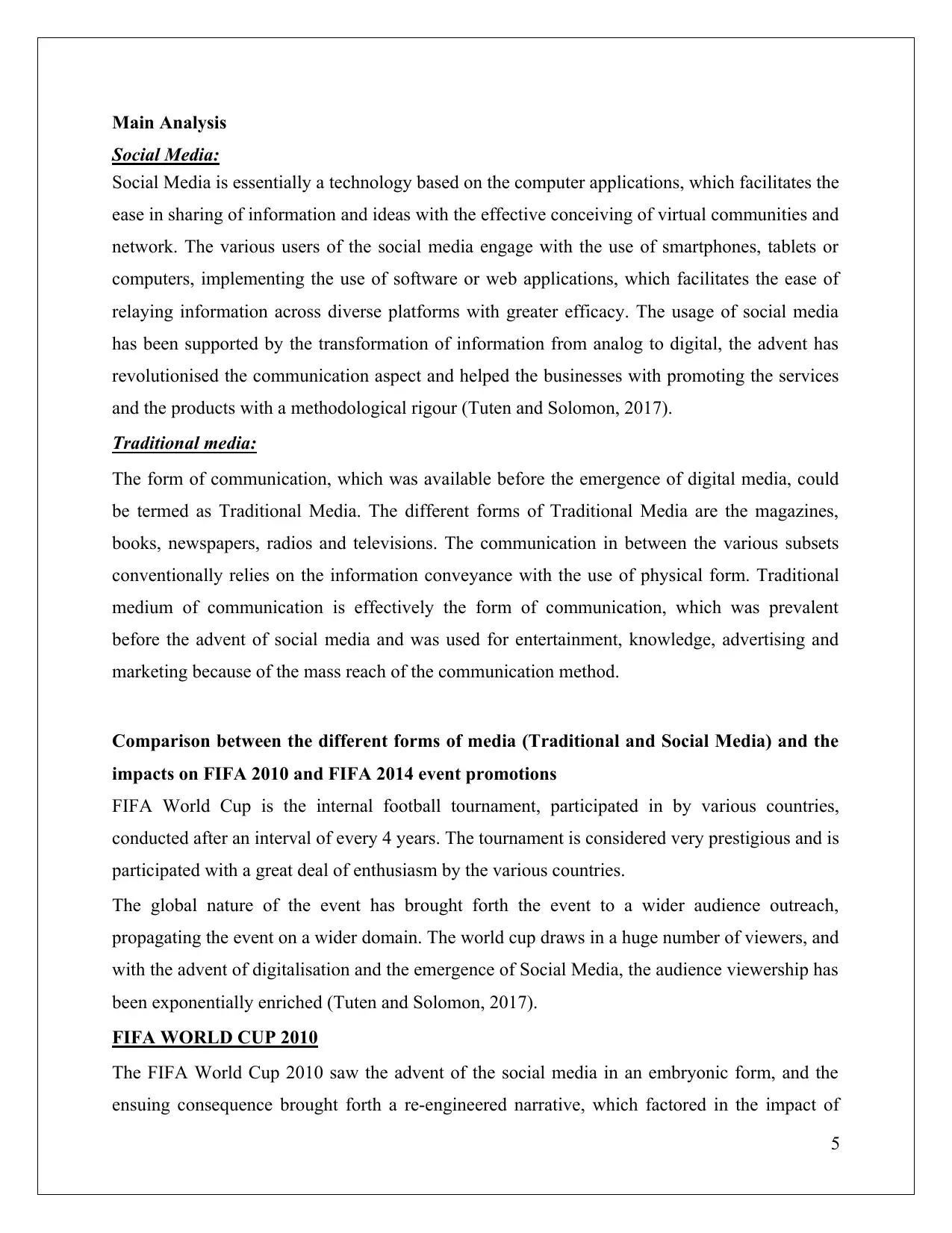
Main Analysis
Social Media:
Social Media is essentially a technology based on the computer applications, which facilitates the
ease in sharing of information and ideas with the effective conceiving of virtual communities and
network. The various users of the social media engage with the use of smartphones, tablets or
computers, implementing the use of software or web applications, which facilitates the ease of
relaying information across diverse platforms with greater efficacy. The usage of social media
has been supported by the transformation of information from analog to digital, the advent has
revolutionised the communication aspect and helped the businesses with promoting the services
and the products with a methodological rigour (Tuten and Solomon, 2017).
Traditional media:
The form of communication, which was available before the emergence of digital media, could
be termed as Traditional Media. The different forms of Traditional Media are the magazines,
books, newspapers, radios and televisions. The communication in between the various subsets
conventionally relies on the information conveyance with the use of physical form. Traditional
medium of communication is effectively the form of communication, which was prevalent
before the advent of social media and was used for entertainment, knowledge, advertising and
marketing because of the mass reach of the communication method.
Comparison between the different forms of media (Traditional and Social Media) and the
impacts on FIFA 2010 and FIFA 2014 event promotions
FIFA World Cup is the internal football tournament, participated in by various countries,
conducted after an interval of every 4 years. The tournament is considered very prestigious and is
participated with a great deal of enthusiasm by the various countries.
The global nature of the event has brought forth the event to a wider audience outreach,
propagating the event on a wider domain. The world cup draws in a huge number of viewers, and
with the advent of digitalisation and the emergence of Social Media, the audience viewership has
been exponentially enriched (Tuten and Solomon, 2017).
FIFA WORLD CUP 2010
The FIFA World Cup 2010 saw the advent of the social media in an embryonic form, and the
ensuing consequence brought forth a re-engineered narrative, which factored in the impact of
5
Social Media:
Social Media is essentially a technology based on the computer applications, which facilitates the
ease in sharing of information and ideas with the effective conceiving of virtual communities and
network. The various users of the social media engage with the use of smartphones, tablets or
computers, implementing the use of software or web applications, which facilitates the ease of
relaying information across diverse platforms with greater efficacy. The usage of social media
has been supported by the transformation of information from analog to digital, the advent has
revolutionised the communication aspect and helped the businesses with promoting the services
and the products with a methodological rigour (Tuten and Solomon, 2017).
Traditional media:
The form of communication, which was available before the emergence of digital media, could
be termed as Traditional Media. The different forms of Traditional Media are the magazines,
books, newspapers, radios and televisions. The communication in between the various subsets
conventionally relies on the information conveyance with the use of physical form. Traditional
medium of communication is effectively the form of communication, which was prevalent
before the advent of social media and was used for entertainment, knowledge, advertising and
marketing because of the mass reach of the communication method.
Comparison between the different forms of media (Traditional and Social Media) and the
impacts on FIFA 2010 and FIFA 2014 event promotions
FIFA World Cup is the internal football tournament, participated in by various countries,
conducted after an interval of every 4 years. The tournament is considered very prestigious and is
participated with a great deal of enthusiasm by the various countries.
The global nature of the event has brought forth the event to a wider audience outreach,
propagating the event on a wider domain. The world cup draws in a huge number of viewers, and
with the advent of digitalisation and the emergence of Social Media, the audience viewership has
been exponentially enriched (Tuten and Solomon, 2017).
FIFA WORLD CUP 2010
The FIFA World Cup 2010 saw the advent of the social media in an embryonic form, and the
ensuing consequence brought forth a re-engineered narrative, which factored in the impact of
5
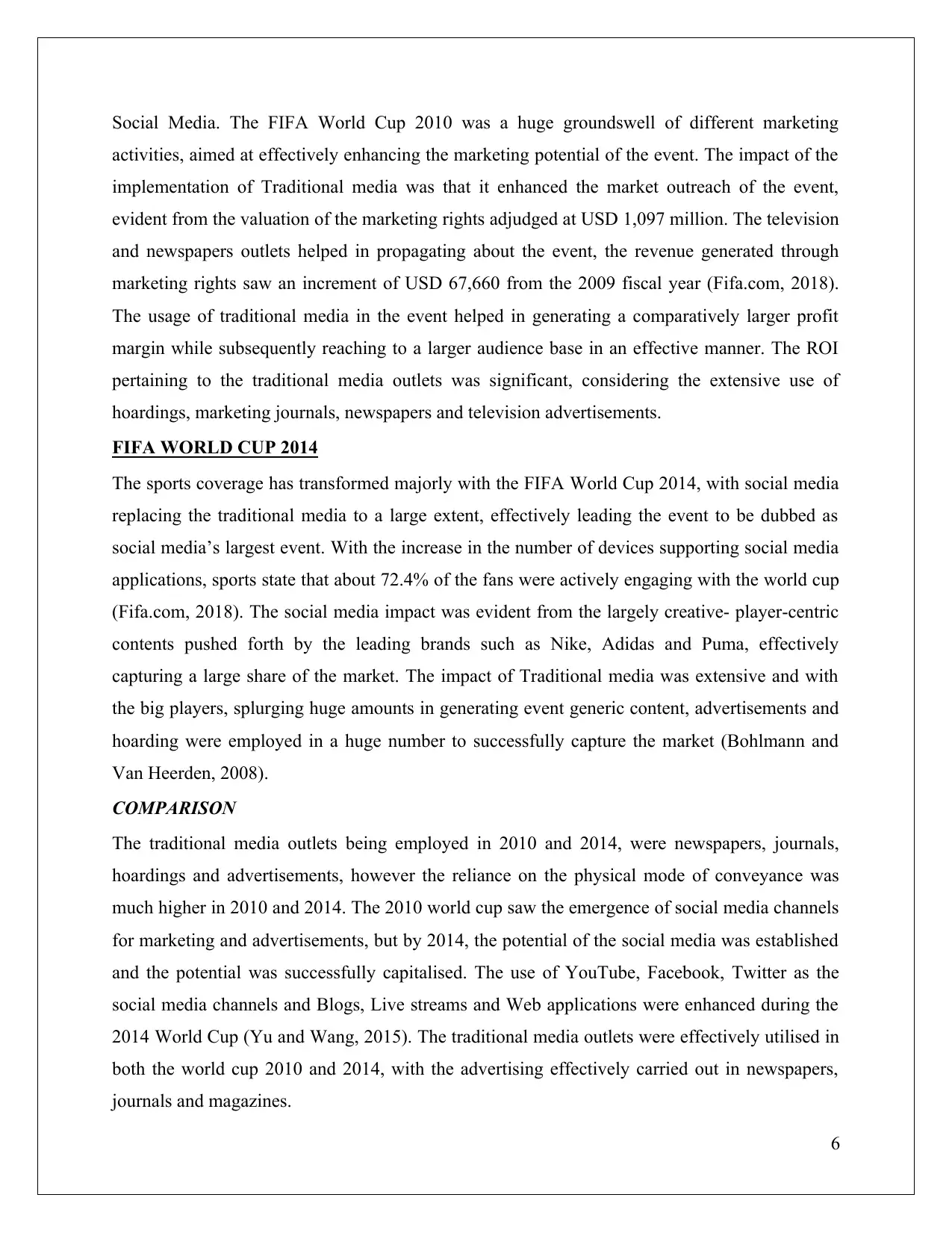
Social Media. The FIFA World Cup 2010 was a huge groundswell of different marketing
activities, aimed at effectively enhancing the marketing potential of the event. The impact of the
implementation of Traditional media was that it enhanced the market outreach of the event,
evident from the valuation of the marketing rights adjudged at USD 1,097 million. The television
and newspapers outlets helped in propagating about the event, the revenue generated through
marketing rights saw an increment of USD 67,660 from the 2009 fiscal year (Fifa.com, 2018).
The usage of traditional media in the event helped in generating a comparatively larger profit
margin while subsequently reaching to a larger audience base in an effective manner. The ROI
pertaining to the traditional media outlets was significant, considering the extensive use of
hoardings, marketing journals, newspapers and television advertisements.
FIFA WORLD CUP 2014
The sports coverage has transformed majorly with the FIFA World Cup 2014, with social media
replacing the traditional media to a large extent, effectively leading the event to be dubbed as
social media’s largest event. With the increase in the number of devices supporting social media
applications, sports state that about 72.4% of the fans were actively engaging with the world cup
(Fifa.com, 2018). The social media impact was evident from the largely creative- player-centric
contents pushed forth by the leading brands such as Nike, Adidas and Puma, effectively
capturing a large share of the market. The impact of Traditional media was extensive and with
the big players, splurging huge amounts in generating event generic content, advertisements and
hoarding were employed in a huge number to successfully capture the market (Bohlmann and
Van Heerden, 2008).
COMPARISON
The traditional media outlets being employed in 2010 and 2014, were newspapers, journals,
hoardings and advertisements, however the reliance on the physical mode of conveyance was
much higher in 2010 and 2014. The 2010 world cup saw the emergence of social media channels
for marketing and advertisements, but by 2014, the potential of the social media was established
and the potential was successfully capitalised. The use of YouTube, Facebook, Twitter as the
social media channels and Blogs, Live streams and Web applications were enhanced during the
2014 World Cup (Yu and Wang, 2015). The traditional media outlets were effectively utilised in
both the world cup 2010 and 2014, with the advertising effectively carried out in newspapers,
journals and magazines.
6
activities, aimed at effectively enhancing the marketing potential of the event. The impact of the
implementation of Traditional media was that it enhanced the market outreach of the event,
evident from the valuation of the marketing rights adjudged at USD 1,097 million. The television
and newspapers outlets helped in propagating about the event, the revenue generated through
marketing rights saw an increment of USD 67,660 from the 2009 fiscal year (Fifa.com, 2018).
The usage of traditional media in the event helped in generating a comparatively larger profit
margin while subsequently reaching to a larger audience base in an effective manner. The ROI
pertaining to the traditional media outlets was significant, considering the extensive use of
hoardings, marketing journals, newspapers and television advertisements.
FIFA WORLD CUP 2014
The sports coverage has transformed majorly with the FIFA World Cup 2014, with social media
replacing the traditional media to a large extent, effectively leading the event to be dubbed as
social media’s largest event. With the increase in the number of devices supporting social media
applications, sports state that about 72.4% of the fans were actively engaging with the world cup
(Fifa.com, 2018). The social media impact was evident from the largely creative- player-centric
contents pushed forth by the leading brands such as Nike, Adidas and Puma, effectively
capturing a large share of the market. The impact of Traditional media was extensive and with
the big players, splurging huge amounts in generating event generic content, advertisements and
hoarding were employed in a huge number to successfully capture the market (Bohlmann and
Van Heerden, 2008).
COMPARISON
The traditional media outlets being employed in 2010 and 2014, were newspapers, journals,
hoardings and advertisements, however the reliance on the physical mode of conveyance was
much higher in 2010 and 2014. The 2010 world cup saw the emergence of social media channels
for marketing and advertisements, but by 2014, the potential of the social media was established
and the potential was successfully capitalised. The use of YouTube, Facebook, Twitter as the
social media channels and Blogs, Live streams and Web applications were enhanced during the
2014 World Cup (Yu and Wang, 2015). The traditional media outlets were effectively utilised in
both the world cup 2010 and 2014, with the advertising effectively carried out in newspapers,
journals and magazines.
6
⊘ This is a preview!⊘
Do you want full access?
Subscribe today to unlock all pages.

Trusted by 1+ million students worldwide
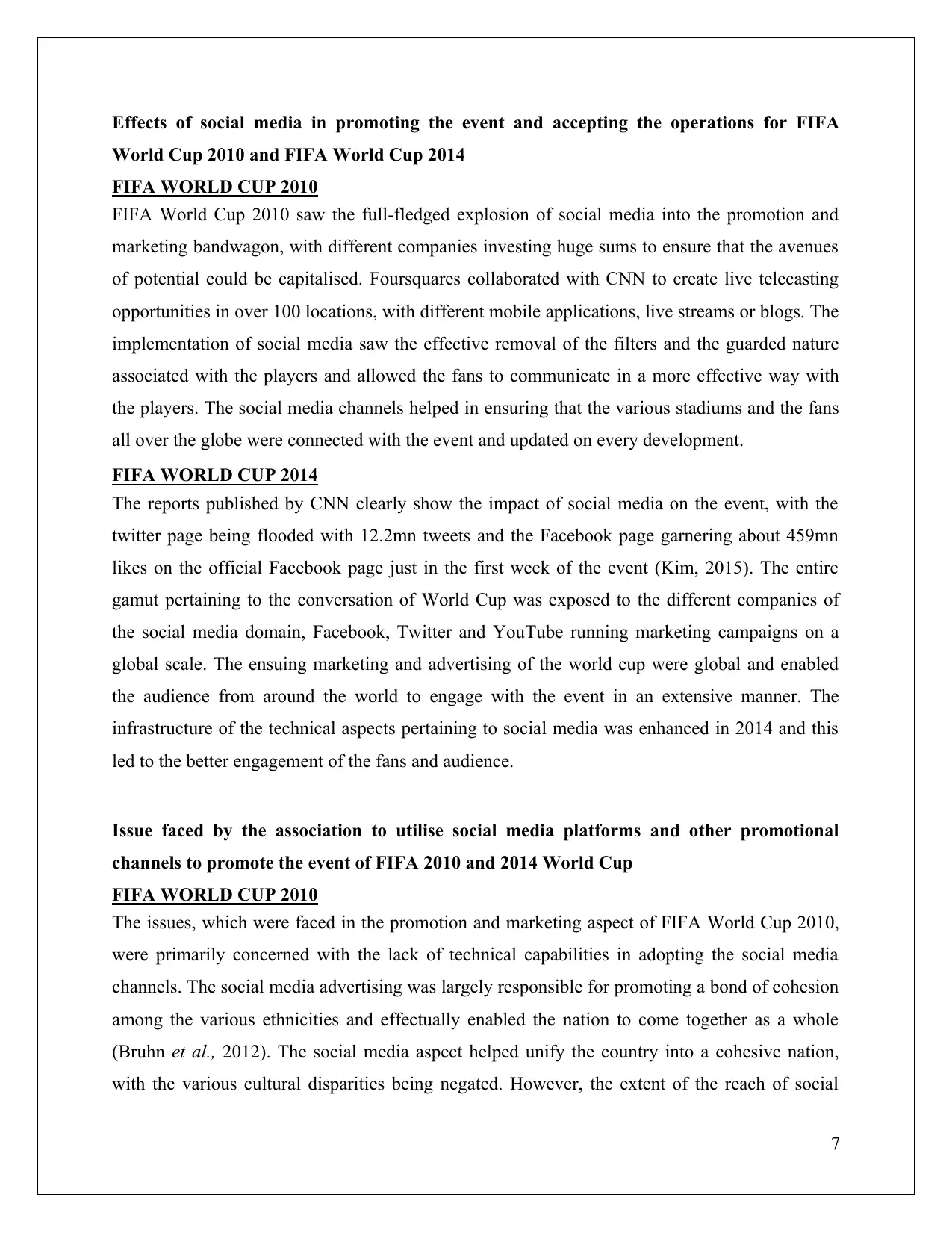
Effects of social media in promoting the event and accepting the operations for FIFA
World Cup 2010 and FIFA World Cup 2014
FIFA WORLD CUP 2010
FIFA World Cup 2010 saw the full-fledged explosion of social media into the promotion and
marketing bandwagon, with different companies investing huge sums to ensure that the avenues
of potential could be capitalised. Foursquares collaborated with CNN to create live telecasting
opportunities in over 100 locations, with different mobile applications, live streams or blogs. The
implementation of social media saw the effective removal of the filters and the guarded nature
associated with the players and allowed the fans to communicate in a more effective way with
the players. The social media channels helped in ensuring that the various stadiums and the fans
all over the globe were connected with the event and updated on every development.
FIFA WORLD CUP 2014
The reports published by CNN clearly show the impact of social media on the event, with the
twitter page being flooded with 12.2mn tweets and the Facebook page garnering about 459mn
likes on the official Facebook page just in the first week of the event (Kim, 2015). The entire
gamut pertaining to the conversation of World Cup was exposed to the different companies of
the social media domain, Facebook, Twitter and YouTube running marketing campaigns on a
global scale. The ensuing marketing and advertising of the world cup were global and enabled
the audience from around the world to engage with the event in an extensive manner. The
infrastructure of the technical aspects pertaining to social media was enhanced in 2014 and this
led to the better engagement of the fans and audience.
Issue faced by the association to utilise social media platforms and other promotional
channels to promote the event of FIFA 2010 and 2014 World Cup
FIFA WORLD CUP 2010
The issues, which were faced in the promotion and marketing aspect of FIFA World Cup 2010,
were primarily concerned with the lack of technical capabilities in adopting the social media
channels. The social media advertising was largely responsible for promoting a bond of cohesion
among the various ethnicities and effectually enabled the nation to come together as a whole
(Bruhn et al., 2012). The social media aspect helped unify the country into a cohesive nation,
with the various cultural disparities being negated. However, the extent of the reach of social
7
World Cup 2010 and FIFA World Cup 2014
FIFA WORLD CUP 2010
FIFA World Cup 2010 saw the full-fledged explosion of social media into the promotion and
marketing bandwagon, with different companies investing huge sums to ensure that the avenues
of potential could be capitalised. Foursquares collaborated with CNN to create live telecasting
opportunities in over 100 locations, with different mobile applications, live streams or blogs. The
implementation of social media saw the effective removal of the filters and the guarded nature
associated with the players and allowed the fans to communicate in a more effective way with
the players. The social media channels helped in ensuring that the various stadiums and the fans
all over the globe were connected with the event and updated on every development.
FIFA WORLD CUP 2014
The reports published by CNN clearly show the impact of social media on the event, with the
twitter page being flooded with 12.2mn tweets and the Facebook page garnering about 459mn
likes on the official Facebook page just in the first week of the event (Kim, 2015). The entire
gamut pertaining to the conversation of World Cup was exposed to the different companies of
the social media domain, Facebook, Twitter and YouTube running marketing campaigns on a
global scale. The ensuing marketing and advertising of the world cup were global and enabled
the audience from around the world to engage with the event in an extensive manner. The
infrastructure of the technical aspects pertaining to social media was enhanced in 2014 and this
led to the better engagement of the fans and audience.
Issue faced by the association to utilise social media platforms and other promotional
channels to promote the event of FIFA 2010 and 2014 World Cup
FIFA WORLD CUP 2010
The issues, which were faced in the promotion and marketing aspect of FIFA World Cup 2010,
were primarily concerned with the lack of technical capabilities in adopting the social media
channels. The social media advertising was largely responsible for promoting a bond of cohesion
among the various ethnicities and effectually enabled the nation to come together as a whole
(Bruhn et al., 2012). The social media aspect helped unify the country into a cohesive nation,
with the various cultural disparities being negated. However, the extent of the reach of social
7
Paraphrase This Document
Need a fresh take? Get an instant paraphrase of this document with our AI Paraphraser
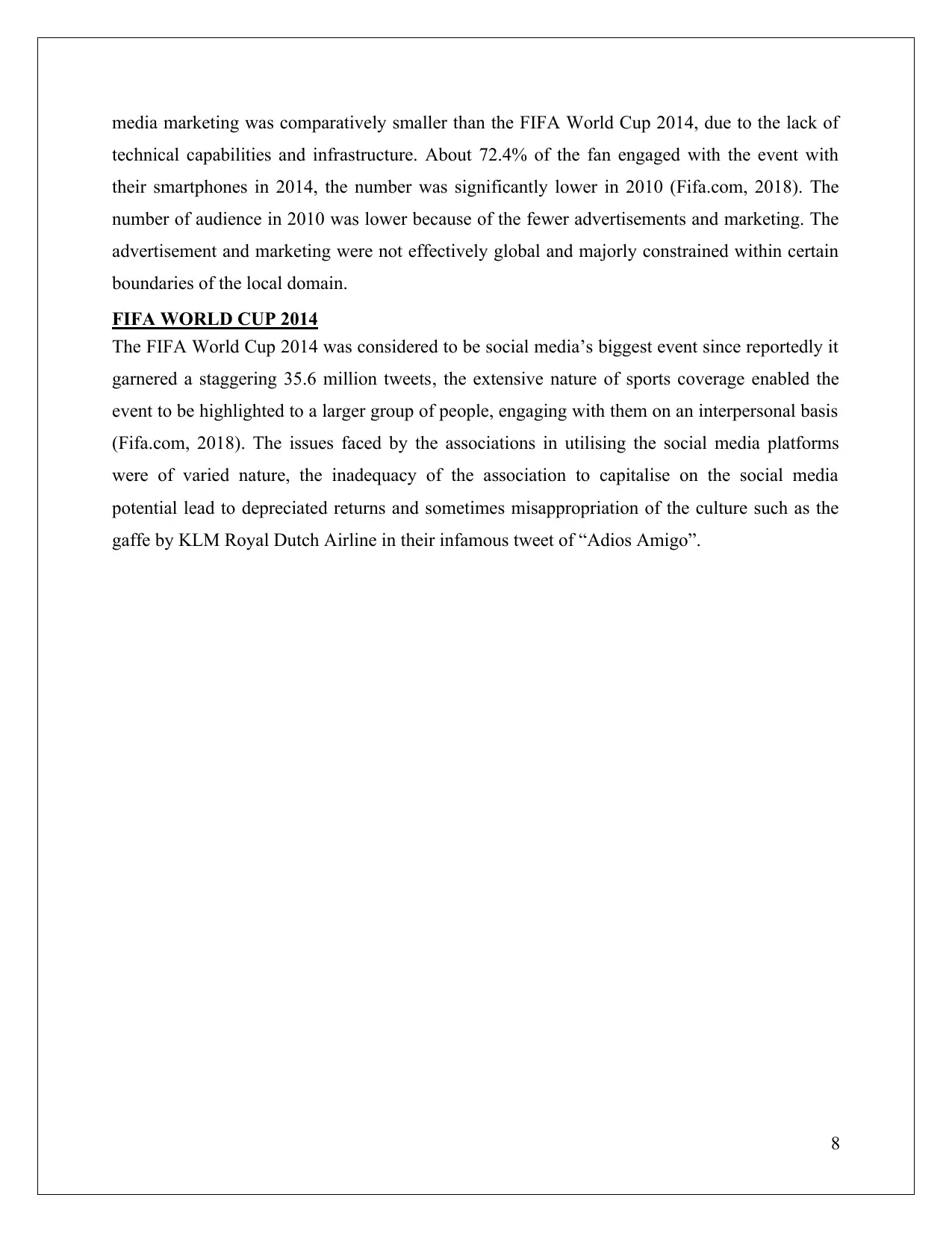
media marketing was comparatively smaller than the FIFA World Cup 2014, due to the lack of
technical capabilities and infrastructure. About 72.4% of the fan engaged with the event with
their smartphones in 2014, the number was significantly lower in 2010 (Fifa.com, 2018). The
number of audience in 2010 was lower because of the fewer advertisements and marketing. The
advertisement and marketing were not effectively global and majorly constrained within certain
boundaries of the local domain.
FIFA WORLD CUP 2014
The FIFA World Cup 2014 was considered to be social media’s biggest event since reportedly it
garnered a staggering 35.6 million tweets, the extensive nature of sports coverage enabled the
event to be highlighted to a larger group of people, engaging with them on an interpersonal basis
(Fifa.com, 2018). The issues faced by the associations in utilising the social media platforms
were of varied nature, the inadequacy of the association to capitalise on the social media
potential lead to depreciated returns and sometimes misappropriation of the culture such as the
gaffe by KLM Royal Dutch Airline in their infamous tweet of “Adios Amigo”.
8
technical capabilities and infrastructure. About 72.4% of the fan engaged with the event with
their smartphones in 2014, the number was significantly lower in 2010 (Fifa.com, 2018). The
number of audience in 2010 was lower because of the fewer advertisements and marketing. The
advertisement and marketing were not effectively global and majorly constrained within certain
boundaries of the local domain.
FIFA WORLD CUP 2014
The FIFA World Cup 2014 was considered to be social media’s biggest event since reportedly it
garnered a staggering 35.6 million tweets, the extensive nature of sports coverage enabled the
event to be highlighted to a larger group of people, engaging with them on an interpersonal basis
(Fifa.com, 2018). The issues faced by the associations in utilising the social media platforms
were of varied nature, the inadequacy of the association to capitalise on the social media
potential lead to depreciated returns and sometimes misappropriation of the culture such as the
gaffe by KLM Royal Dutch Airline in their infamous tweet of “Adios Amigo”.
8
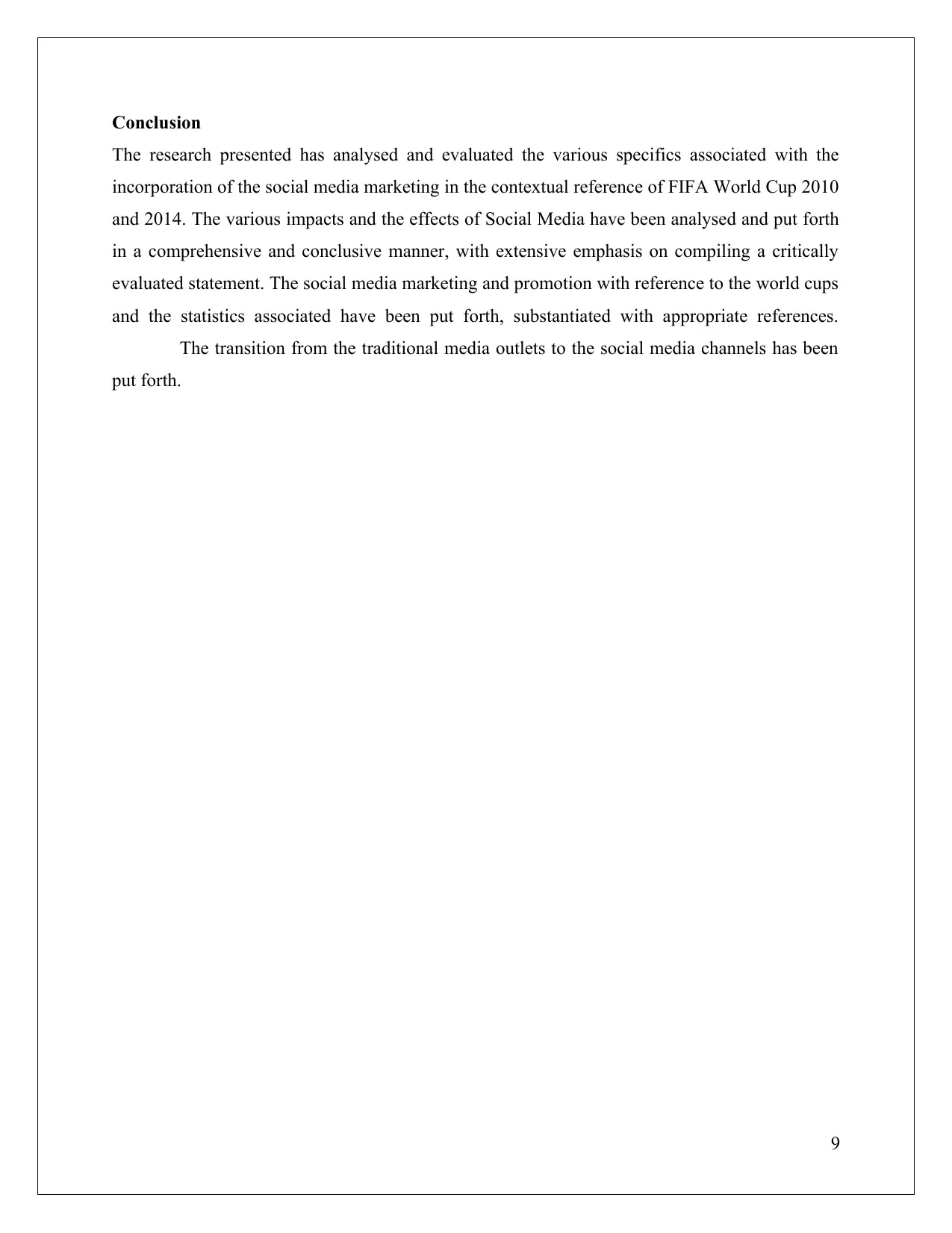
Conclusion
The research presented has analysed and evaluated the various specifics associated with the
incorporation of the social media marketing in the contextual reference of FIFA World Cup 2010
and 2014. The various impacts and the effects of Social Media have been analysed and put forth
in a comprehensive and conclusive manner, with extensive emphasis on compiling a critically
evaluated statement. The social media marketing and promotion with reference to the world cups
and the statistics associated have been put forth, substantiated with appropriate references.
The transition from the traditional media outlets to the social media channels has been
put forth.
9
The research presented has analysed and evaluated the various specifics associated with the
incorporation of the social media marketing in the contextual reference of FIFA World Cup 2010
and 2014. The various impacts and the effects of Social Media have been analysed and put forth
in a comprehensive and conclusive manner, with extensive emphasis on compiling a critically
evaluated statement. The social media marketing and promotion with reference to the world cups
and the statistics associated have been put forth, substantiated with appropriate references.
The transition from the traditional media outlets to the social media channels has been
put forth.
9
⊘ This is a preview!⊘
Do you want full access?
Subscribe today to unlock all pages.

Trusted by 1+ million students worldwide
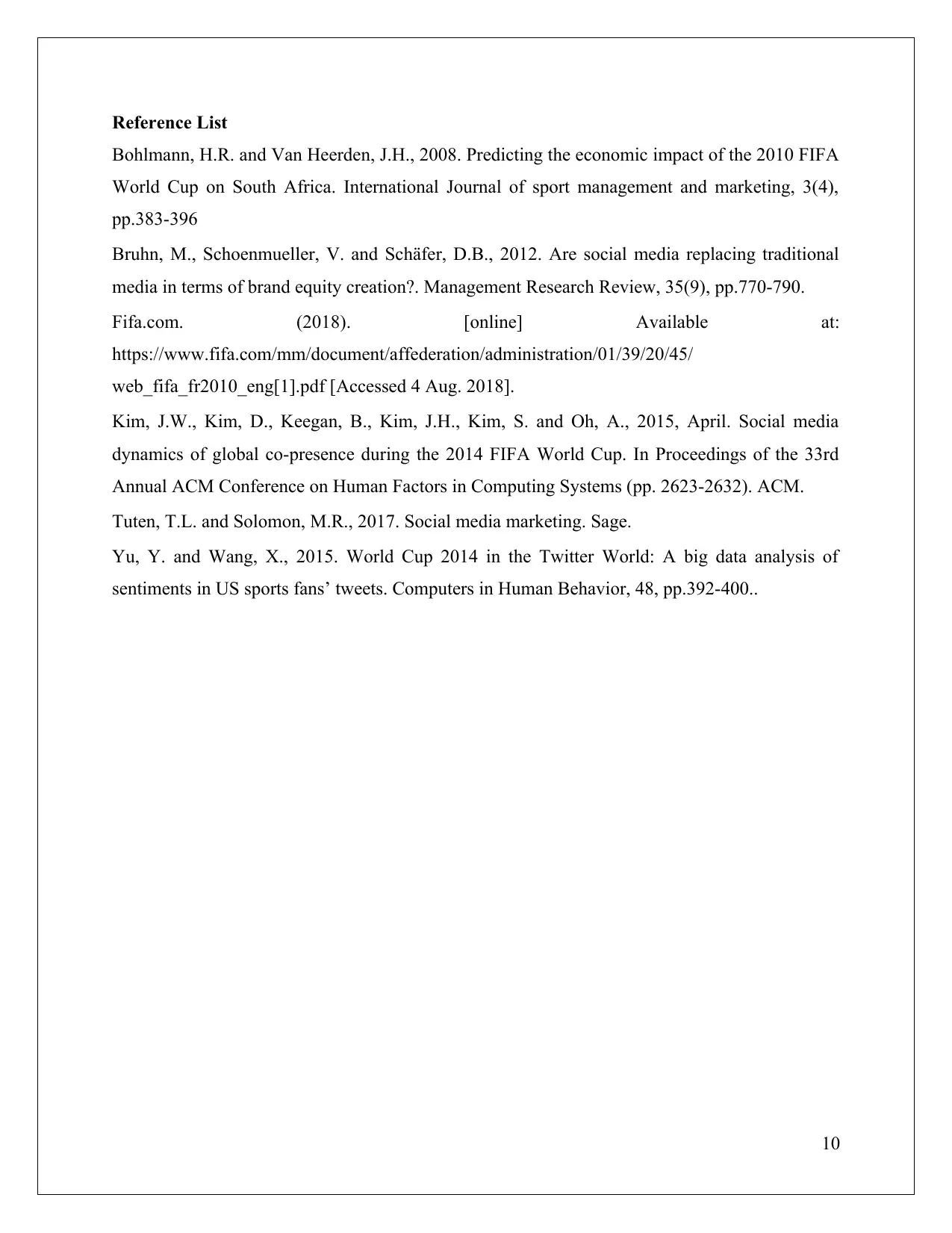
Reference List
Bohlmann, H.R. and Van Heerden, J.H., 2008. Predicting the economic impact of the 2010 FIFA
World Cup on South Africa. International Journal of sport management and marketing, 3(4),
pp.383-396
Bruhn, M., Schoenmueller, V. and Schäfer, D.B., 2012. Are social media replacing traditional
media in terms of brand equity creation?. Management Research Review, 35(9), pp.770-790.
Fifa.com. (2018). [online] Available at:
https://www.fifa.com/mm/document/affederation/administration/01/39/20/45/
web_fifa_fr2010_eng[1].pdf [Accessed 4 Aug. 2018].
Kim, J.W., Kim, D., Keegan, B., Kim, J.H., Kim, S. and Oh, A., 2015, April. Social media
dynamics of global co-presence during the 2014 FIFA World Cup. In Proceedings of the 33rd
Annual ACM Conference on Human Factors in Computing Systems (pp. 2623-2632). ACM.
Tuten, T.L. and Solomon, M.R., 2017. Social media marketing. Sage.
Yu, Y. and Wang, X., 2015. World Cup 2014 in the Twitter World: A big data analysis of
sentiments in US sports fans’ tweets. Computers in Human Behavior, 48, pp.392-400..
10
Bohlmann, H.R. and Van Heerden, J.H., 2008. Predicting the economic impact of the 2010 FIFA
World Cup on South Africa. International Journal of sport management and marketing, 3(4),
pp.383-396
Bruhn, M., Schoenmueller, V. and Schäfer, D.B., 2012. Are social media replacing traditional
media in terms of brand equity creation?. Management Research Review, 35(9), pp.770-790.
Fifa.com. (2018). [online] Available at:
https://www.fifa.com/mm/document/affederation/administration/01/39/20/45/
web_fifa_fr2010_eng[1].pdf [Accessed 4 Aug. 2018].
Kim, J.W., Kim, D., Keegan, B., Kim, J.H., Kim, S. and Oh, A., 2015, April. Social media
dynamics of global co-presence during the 2014 FIFA World Cup. In Proceedings of the 33rd
Annual ACM Conference on Human Factors in Computing Systems (pp. 2623-2632). ACM.
Tuten, T.L. and Solomon, M.R., 2017. Social media marketing. Sage.
Yu, Y. and Wang, X., 2015. World Cup 2014 in the Twitter World: A big data analysis of
sentiments in US sports fans’ tweets. Computers in Human Behavior, 48, pp.392-400..
10
1 out of 10
Related Documents
Your All-in-One AI-Powered Toolkit for Academic Success.
+13062052269
info@desklib.com
Available 24*7 on WhatsApp / Email
![[object Object]](/_next/static/media/star-bottom.7253800d.svg)
Unlock your academic potential
Copyright © 2020–2025 A2Z Services. All Rights Reserved. Developed and managed by ZUCOL.




